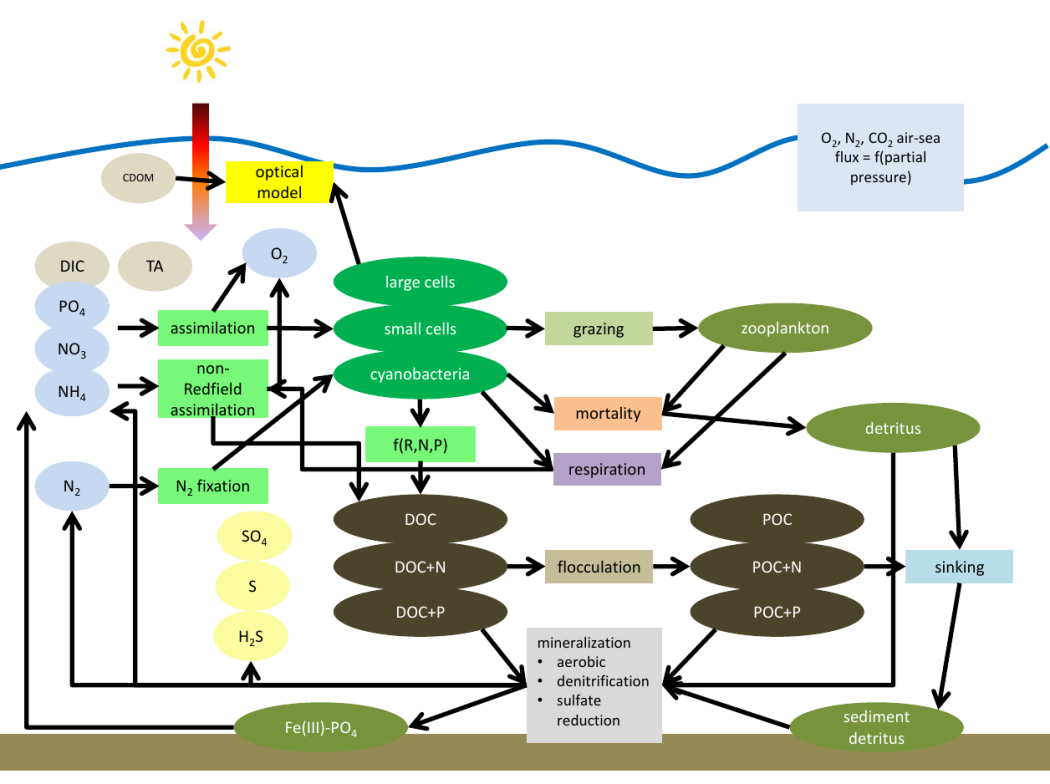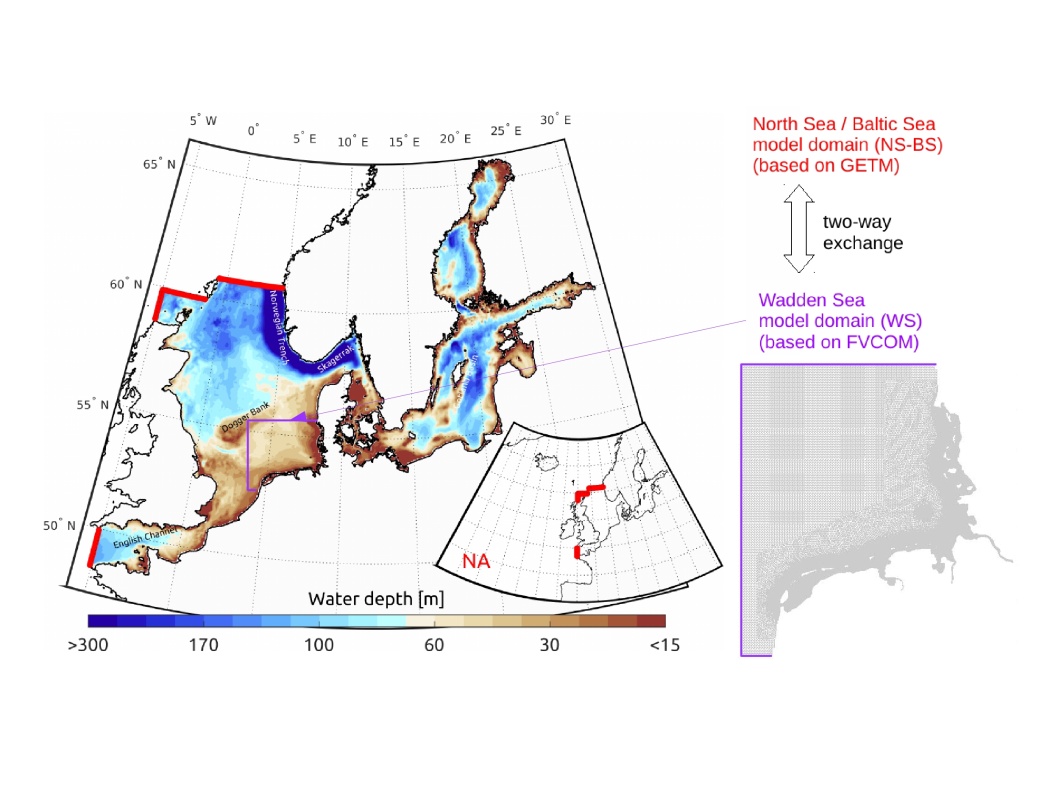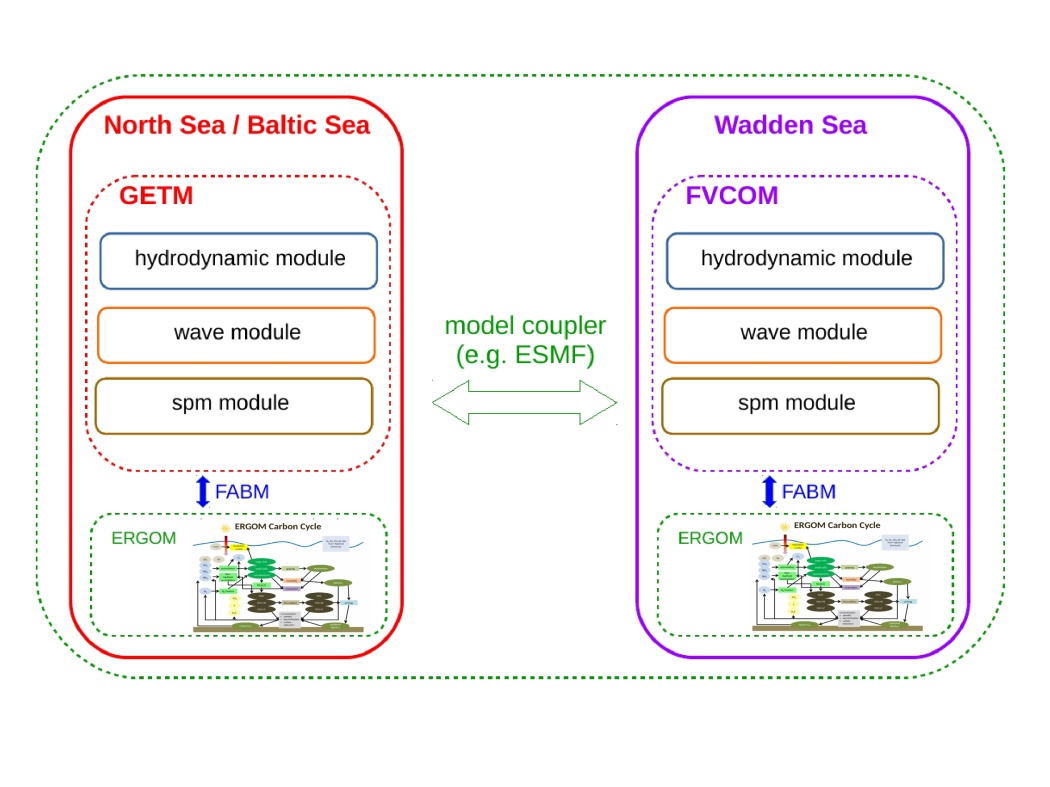To simulate the reaction of the North-Sea/Baltic-Sea region with a special focus on carbon storage capacities for present and future climatic conditions and possible anthropogenic disturbances, a coupled hydrodynamic-biogeochemical modelling system will be developed. In detail, we will estimate balances of organic matter, nutrients, total alkalinity (TA), and dissolved inorganic carbon (DIC) for the North-Sea/Baltic-Sea region.
The modelling system is based on the regular-grid model GETM, which covers the overall North Sea and Baltic Sea (NS-BS model), and the unstructured-grid model FVCOM, which covers the Wadden Sea area (WS model) within the southern North Sea. As illustrated in the figure below, different submodules for biogeochemistry, suspended sediment, and surface gravity waves will be included in each of the two modelling systems, for which the the FABM tool-kit, will also be used.
Finally, the NS-BS model and the WS model will be coupled in a two-way-nesting style using the model coupling software ESMF (Earth System Modeling Framework). In the bottom figures, the processes included within the biogeochemistry model ERGOM are illustrated in more detail.
Hydrodynamic-biogeochemical model for the North Sea-Baltic Sea continuum
In work package 3.1, a tested hydrodynamic-biogeochemical coupled model for the North Sea (NS) and the Baltic Sea (OS) will be developed based on GETM and ERGOM. This model system will be bidirectionally coupled with the high-resolution hydrodynamic-biogeochemical model FVCOM / ERGOM for the Wadden Sea (WM). With this overall system we will integrate and analyze CO2-relevant processes in space and time.
To couple the model systems GETM-ERGOM (NS-OS) and FVCOM-ERGOM (WM) bidirectionally, the software package ESMF (Earth System Modeling Framework) will be used, which is implemented in FVCOM as well as in GETM.
The goal is to generate a hindcast for the period 1995-2020, which will be used as a reference run. For this period, forcing datasets of very good quality exist: for the atmosphere COSMO-REA6 (Bollmeyer et al., 2015), flux inputs, as well as boundary data for the North Atlantic (NEMO-ERSEM, 7km, Marine Copernicus Service). For the North Sea area, the reference run is validated with data from the Biogeochemical Climatology of the North Sea.
Accounting for key components
For each of the areas (North Sea, Baltic Sea, Wadden Sea) balances of organic matter, nutrients, TA, and DIC will be developed. This will include fluxes across model boundaries. The associated simulated respiratory fluxes (CO2 and TA) will be estimated for different climate scenarios and different direct anthropogenic actions expressed in terms of variable flux loads, sea level changes, variations in wind characteristics, and atmospheric deposition.
New parameterization of processes in the carbonate system
Using results from work packages 1 and 2, a balance of total alkalinity (TA) is established that takes into account the TA-generating processes of the sediment, the tidal flats, and the changing land-based TA outflows. Here, the balance between simulated respiration and TA generation determines CO2 exchange with the atmosphere. To better represent this in the model system, the following new processes and parameterizations will be implemented in ERGOM:
- Review of alkalinity modifying processes in pelagic and sediment
- Review/implementation of DOM alkalinity dynamics
- Extension of carbon cycle to include 13C
- Introduction of calcareous shell formers and dissolution of calcareous shells
For the planned extensions of the ERGOM model, work package (WP) 3 is dependent on the results and contributions, as well as the cooperation with WP 1 and WP 2.
- The alkalinity sensitivity of the model will be significantly improved in the Baltic Sea region through the studies in WP 1.1. The river data will be updated and the pCO2 results of the model will be compared with the measured pCO2 time series. This will serve to further calibrate the model.
- The observations in the area of the East Frisian Wadden Sea (WP 1.2) support the calibration of the model system, which is characterized by special dynamics especially in this sea area. Especially the high-frequency data from the Spiekeroog monitoring pile as well as precise and high-resolution ship-based transect data from the NLWKN are thus of great importance.
- Both the field measurements and the laboratory experiments in WP 1.3 contribute to calibrate the exchange between pore water and the pelagic in the model, depending on the sediment type and other environmental conditions. This concerns not only the physical exchange, but especially the exchange of carbon, alkalinity, organic particles and nutrients.
- The measurements in WP 1.4 on gas exchange can improve existing bulk formulations for gas exchange at the ocean-atmosphere boundary. In particular, these are relevant relative to distance from shore, since the conventional bulk formulations tend to apply to the open ocean.
- In the North Sea region, common ratios of buried carbon ("burial") to vertically exported carbon are about 1%. This very rough estimate will be refined in WP 1.5 and will thus help to constrain the variations in model results in this area, especially in the coastal region.
- The isotopic measurements in AP 2.1 in the sediment will help to improve the carbon and alkalinity balance of the model. The stable isotope modeling is calibrated by these measurements.
- Dissolution of calcite occurs only biologically in shallow waters such as the North Sea and Baltic Sea. So far, the model does not include this process. The measurements in WP 2.2 will improve the parameterization to be developed, and environmental conditions can then control this process in the model.
- The simulated basin-wide pH values and alkalinity concentrations in the sediment can make the work in WP 2.3 more informative by interpolating or extrapolating the concentrations of trace substances.
Sensitivity runs and evaluation
These studies are intended to investigate the sensitivity of the coupled system to expected changes in terms of carbon storage capacity. Regional (e.g., inputs) and global (e.g., warming) pressures will be considered.
Different model runs considering sources from rivers and atmospheric deposition will reflect oligotrophic and/or eutrophic conditions. This will involve filling the various DOC reservoirs in conjunction with these sensitivity runs and analyzing different export rates
and/or degradation rates will be analyzed. Results from the stable isotope studies (AP1 and AP2) will constrain uncertainties in carbon and nitrogen turnover.
Although identical assumptions for future changes are to be made for the North Sea and the Baltic Sea, they still have different implications for the individual systems.
Sea level change projections will have a large impact on hydrodynamics in the tidal flats. For example, tidal components M2 and M4, which control tidally driven residual currents in the tidal flats, will shift, among others. In addition, wave heights in the back tidal flats will likely increase, due to less depth-induced wave breaking. Conditional on the exposed westerly wind position of the Frisian Islands, changes in wind direction and speed will have a direct effect on tidal channels and water exchange in the tidal flats. Due to the sheltered location from westerly winds, these factors will have a rather minor influence on the German Baltic Sea coast. For the Baltic Sea, changes in runoff and nutrient loads will be more decisive. Changes in mean water level or wind speeds will have an indirect influence through changes in deep water formation and saltwater intrusion.
Even though the different system responses of the Baltic and North Sea hydrodynamics can already be outlined relatively clearly, changes in biogeochemistry, for example in the carbon cycle, are difficult to estimate.
To account for this, we will perform several sensitivity runs to possible change. We will modify boundary values and input data to the existing reference hindcast from WP3.1 to quantify the impact of individual possible future climate factors on carbon storage capacity. The goal here is to create a catalog describing system responses for, e.g., a sea level rise of 50 cm/century, a 5% increase in wind speed, or a 2 K/century increase in mean air temperature. Thus, for various future assumptions, the potential changes in carbon storage can be quantified and used for planning purposes. The final sensitivity runs will be developed in close coordination with WP4.1 and WP4.3. The addressed catalog of system responses will be processed using a Bayesian network, assuming little interaction between the different model runs, and can then be used as an interactive tool by decision makers in AP4.3.
The following table lists possible sensitivity runs. The exact definition of the sensitivity runs (in scope, number, parameters to be varied) will be finally determined by the consortium at the kick-off meeting. Furthermore, additional parameter variations/requests from stakeholders will still be included in coordination with WP4. In the following we list possible parameter variations and sensitivity runs:
| Parameter | Changes |
|---|---|
| Sea level rise (F3, F7) | 1. 0.50m / century 2. 0.75m / century 3. 1.00m /century |
| Wind (F3) | 1. 5% increase in mean wind speed 2. Increase of strong winds 3. 10° change in mean wind direction |
| Increase of air temperature (F7) | 1. +1 K / century 2. +2 K / century 3. +4 K / century 4. Stronger increase of winter temperature 5. Stronger increase of summer temperature |
| Runoff (F7) | 1. Changes in annual cycle (wetter winters and drier summers). 2. variation of annual runoff by 5%. |
| Carbon (F7) | 1. Input from the North Atlantic Ocean 2. River loads |
| Nitrogen | 1. Input through the North Atlantic (F7,F8) 2. River loads (F1, F8) 3. Atmospheric deposition (F9) |
| Phosphorus | 1. Input through the North Atlantic (F7,F8) 2. River loads (F1) |
| Silicate | 1. River loads (F1) |
| Alkalinity | 1. River loads (F7, F8, F9) |
| Organic material | 1. River loads (F8, F9) 2. Import into the Wadden Sea (F6) |
Quantification of the DOS source strengths and the distribution of Ra isotopes
In order to quantify the inputs of dissolved organic sulfur (DOS) to the North Sea and Baltic Sea and to determine the distribution of different Ra isotopes (223Ra, 224Ra, 226Ra, 228Ra) in the North Sea and Baltic Sea, these species will be implemented in the ERGOM modules of both model systems (NS-BS and WS, respectively) as passive tracers with possible decay dynamics and potential sources/sinks. Thus, in particular, the determination of source strengths of the DOS from anoxic/suboxic areas of the water column within the Baltic Sea as well as from sulfidic sediments of the North Sea and the Wadden Sea as envisioned in WP 1.3 can be supported by model simulations (contribution to key question F5). Furthermore, the tracer studies planned in WP 1.2 to determine TA dynamics can be accompanied and supported by explicit modeling of the mentioned Ra isotopes (contribution to key question F9).
In order to determine the DOS source strengths, analogous to the Greens functions method for solving linear inhomogeneous partial differential equations for point sources, the first step is to use the model systems to determine the quasi-stationary distribution of these species in the North Sea and Baltic Sea for individual source locations (e.g., in the Wadden Sea or in the anoxic/suboxic basins of the Baltic Sea) based on unit discharges. In a second step, based on these simulations and using the quantitative measurements of these species in WP 1.3 at different locations in the North Sea and Baltic Sea, an inverse mathematical procedure can then be used to determine the source strengths for these individual source locations. Appropriate algorithms for this inverse modeling will then be implemented in Matlab starting around the 18th month of the project, so that they will be ready for use to quantify the source strengths as soon as both the model simulations and the measurements from WP 1.3 are available.
To determine the distributions of the Ra isotopes, these will be implemented in the corresponding ERGOM modules of the NS-OS and WS model systems, respectively. For the specification of the source strengths of the Ra isotopes in the considered model regions, known source strengths as well as new measurements of the same from WP 1.2 are used. Based on these source strengths, Ra distributions are then simulated for selected external forcing conditions in the North and Baltic Seas. This allows to discriminate autochthonous and allochthonous TA related processes.
Contact
Institute for Chemistry and Biology of the Marine Environment (ICBM)
Phone: +49 441 798 4061
E-mail contactLeibniz-Institute for Baltic Sea Research
Phone: +49 381 5197 358
E-mail contact


